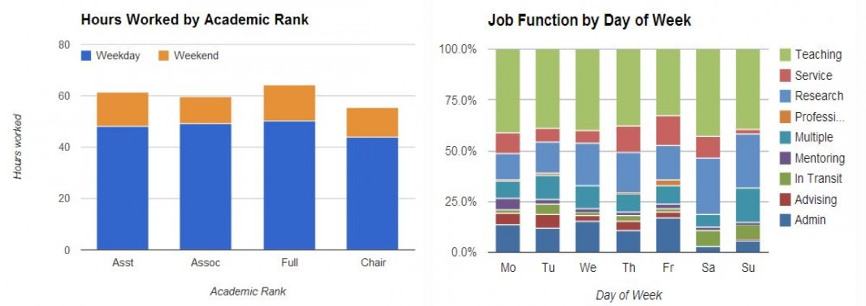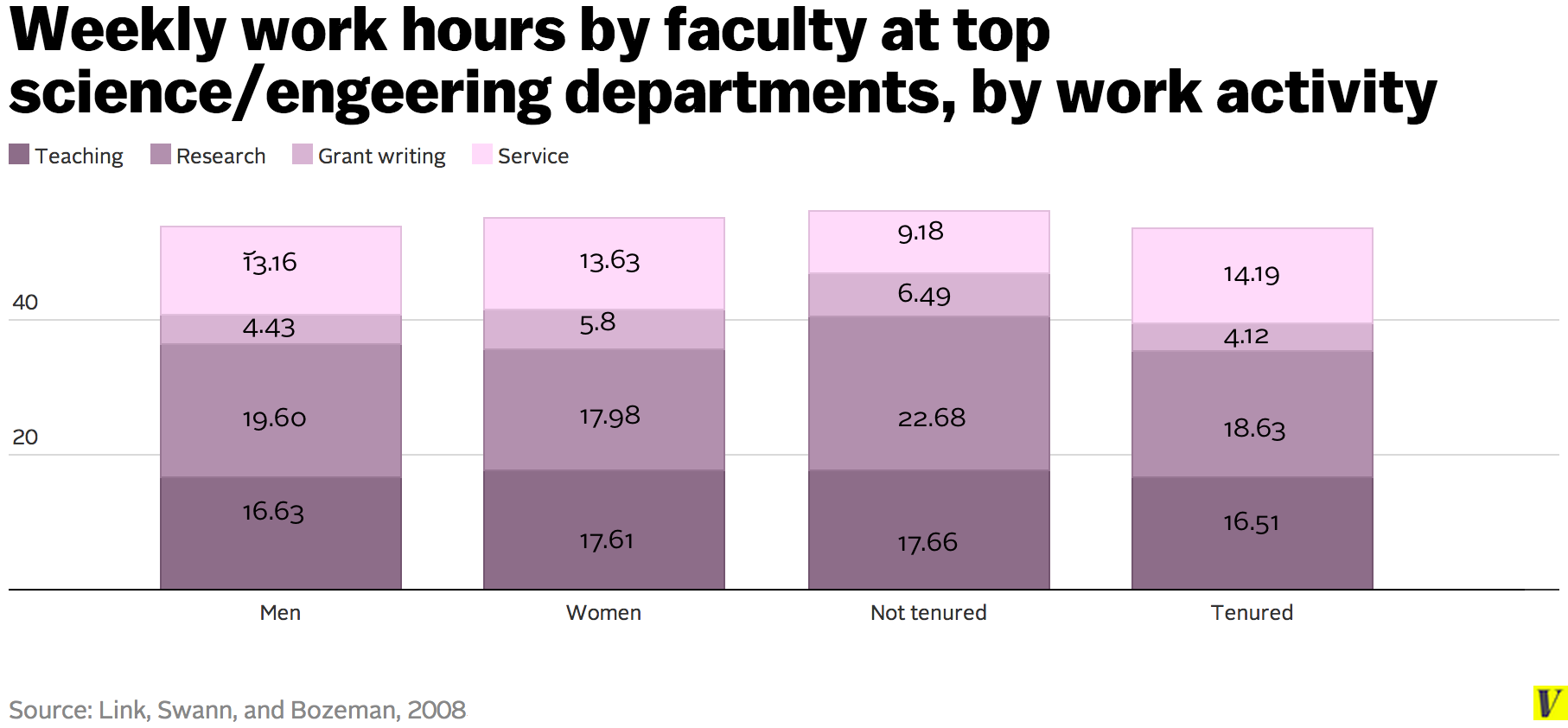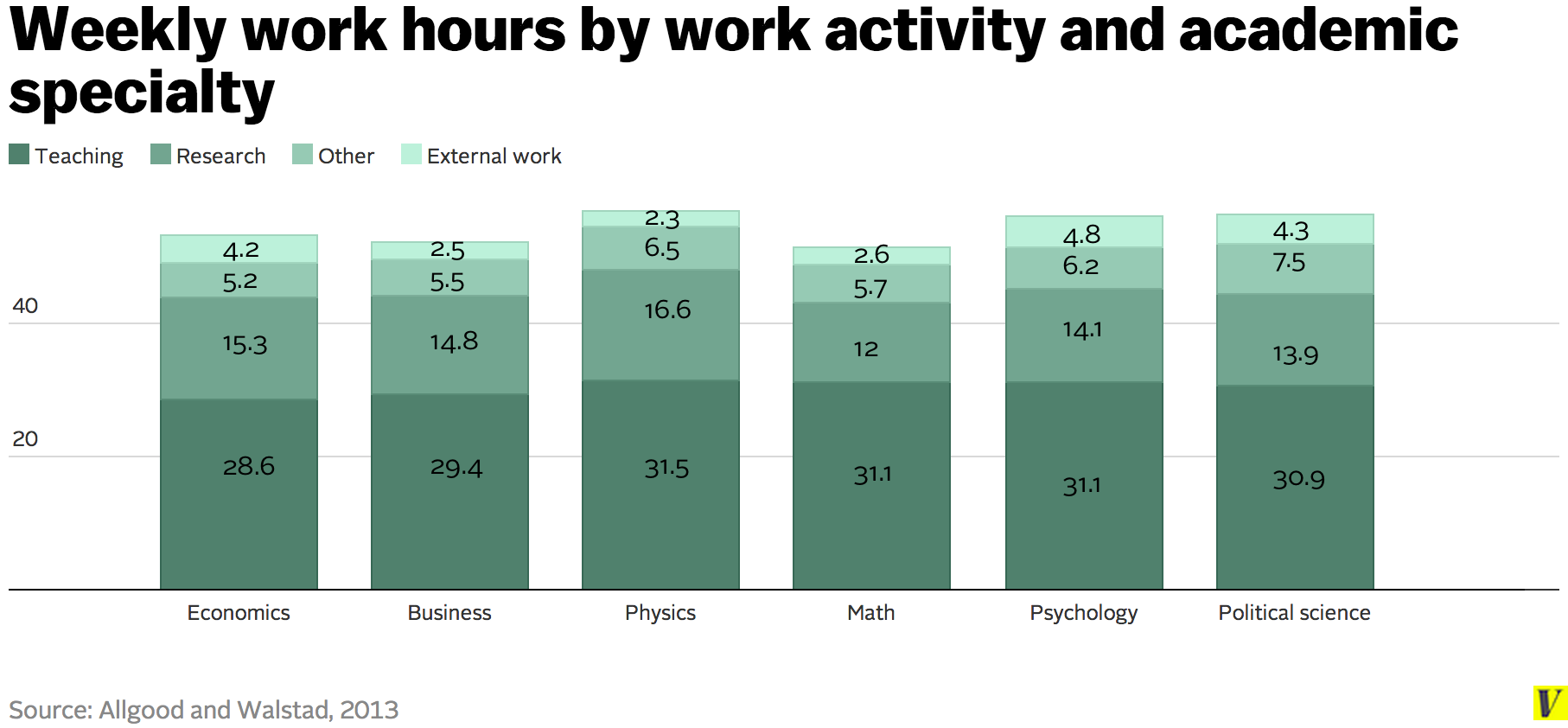Accueil > Revue de presse > À l’étranger > Being a college professor isn’t really a cushy job - Dylan Matthews, (...)
 Being a college professor isn’t really a cushy job - Dylan Matthews, Vox.com,April 24, 2014
Being a college professor isn’t really a cushy job - Dylan Matthews, Vox.com,April 24, 2014
samedi 26 avril 2014, par
Boise State University anthropologist John Ziker has spent much of his career studying the cultural practices of indigenous people in Siberia (sample paper title : "’Horseradish Is No Sweeter than Turnips’ : Entitlements and Sustainability in the Taimyr Autonomous Region, Northern Russia"). Now chair of his department, he’s started doing fieldwork on something a bit closer to home : the practices of academics at Boise State.
His research suggests that his colleagues work fairly long hours (61 hours a week, on average), and that they spend, on average, only about 35 percent of their work weeks teaching :

Perhaps most striking is Ziker’s finding that 17 percent of workdays are spent in meetings, including advising sessions with student and departmental and committee meetings with faculty and administrators. The life of an academic, by his tallying, involves a frustrating amount of bureaucratic drudgery.
But Boise State is only one school, and Ziker’s study is, as Occidental sociologist Lisa Wade points out, "a small, non-random sample at just one university." Luckily, larger and more representative samples have been taken by researchers concerned with the same question. Here are five things we learned from these other, more comprehensive inquiries into academic life.
1. Getting tenure adds 5 hours of bureaucratic nonsense service duties to science professors’ weeks
A 2008 study by UNC - Greensboro’s Albert Link and Christopher Swann and University of Georgia’s Barry Bozeman looks at the time use of 1,365 scientists and engineers at 150 highly ranked research universities from 2004 to 2005. 200 men and 200 women from each of twelve academic fields were surveyed, and the results were weighted to reflect the actual gender and discipline makeup of the universities in question (shamefully, only 11 percent of science/engineering professors at the universities in question were women).
Their findings on total time worked weren’t too different from Ziker’s, with the average faculty member putting in 54 hours of work a week. But the differences they found between tenure and non-tenured faculty — and between men and women — were interesting :

Men teach less and do more research than women, who also have to do more grant writing. Tenured professors do less research and teaching, but face a 5-hour-a-week spike in service responsibilities (serving on committees, helping with departmental functions, etc).
2. Physicists work harder on almost every dimension
University of Nebraska - Lincoln economists Sam Allgood and William Walstad used a 2003-2004 survey — the National Study of Postsecondary Faculty (NSOPF) — from the Department of Education’s National Center for Education Statistics to estimate faculty time use across a few specific disciplines. The total sample included over 35,000 faculty members ; notably, they excluded adjunct instructors, including only full-time tenured or tenure-track faculty members. They found that physicists were workhorses, relatively speaking, putting in more teaching and research hours than other disciplines. Mathematicians reported the lowest research time of the disciplines examined, and economists put in the least time teaching. Interestingly, psychology, political science, and economics faculty did more work outside of academia than business faculty :

They too found overall work figures similar to Zikler’s : 54.2 hours a week overall.
3. Research university faculty shift their time toward, well, research
Using a national survey of 477 economics instructors (including adjuncts), Easter Kentucky’s Cynthia L. Harter, Indiana’s William Becker, and Purdue’s Michael Watts found that, in 2005, the teaching/research balance for economics faculty was heavily dependent on the type of school they taught at. At large research universities, economists are (as you’d expect) more research focused than at master’s and bachelor’s-focused schools (all figures below are percentages) :
However, the survey had a very low response rate, and Becker and Watts caution that they cannot know "whether respondents are representative of all US teachers of undergraduate economics courses."
"research time has fallen by a third from 1992 to 2007, from 18 hours to 12 hours a week"
4. Research time is falling
George Washington’s Mikyong Minsun Kim and William Cummings used an international survey of academics (including adjuncts), which included 1,146 American faculty members from 80 institutions, to compare practices in the US and South Korea, and found that US teaching hours have stayed largely constant but research time has fallen by a third from 1992 to 2007, from 18 hours to 12 hours a week. Teaching time increased slightly from 19 hours a week to 21. Korea, by contrast, has seen teaching time fall from 23 hours a week to 21, and research time stayed constant at 18.
5. Women do less research and more teaching — and not just because they want to
Sarah Winslow at Clemson used an earlier version of the National Study of Postsecondary Faculty than that used in the Allman and Walstad paper to examine differences in male and female faculty members’ time use. She confirmed that women do in fact teach more — by about an hour a week — and research less than men. That’s partly a matter of men and women having different preferences, though those preferences are themselves formed by the structure of academia, where women’s preferences may have adapted to account for having fewer opportunities than men.
In any case, preferences are not the whole story. "Differences in preferences account for approximately 50 percent of the sex gap in time allocated to teaching," Winslow concludes. Women’s "actual time allocations to both teaching and research diverge more from their preferred time allocations than those of men."


